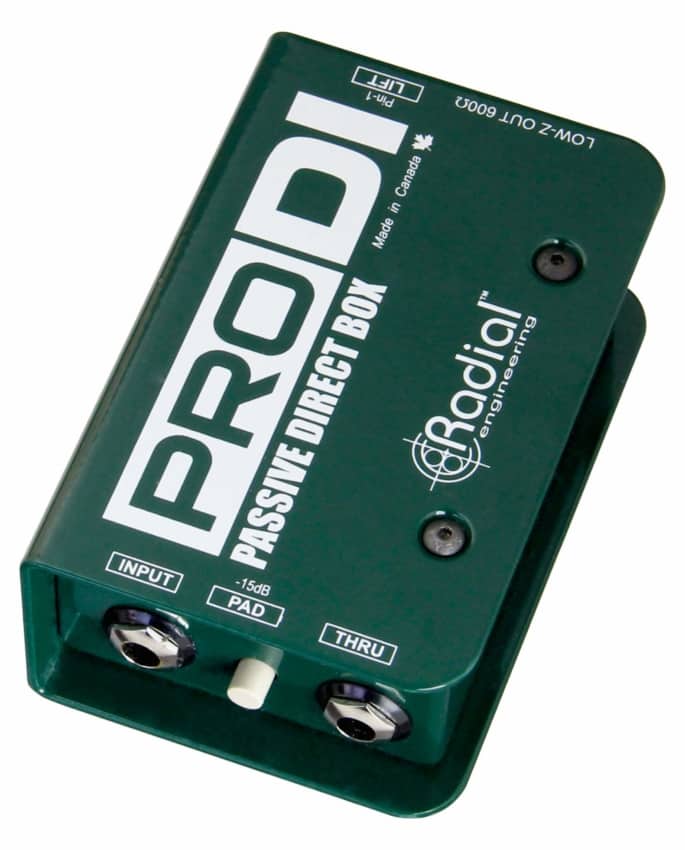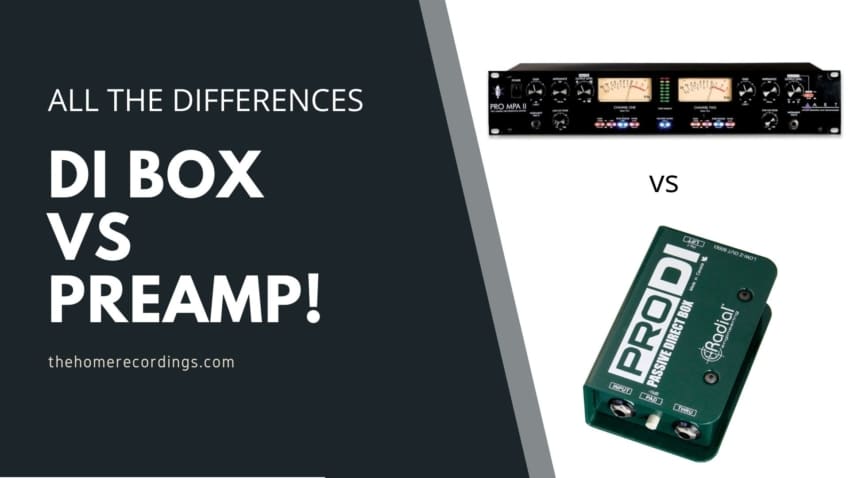Have you ever wondered what the difference between a DI box and a preamp is?
Well, in this post I will do my best to give you a good answer to the question as well as give you some detailed information about both, which ones to get, where to get them, and more.
So, without any further ado, let’s get started!
The differences between a DI box and a preamp are;
A DI box converts a high impedance signal to a low impedance signal that a mic pre can deal with, and it also features parallel inputs to plug the guitar into it and have the signal go to the amp as well as the preamp.
Mic Preamps are designed to take a mic level signal and bring it up to line level, and the preamps that have DI inputs generally do not have the parallel feed for your amp.
Essentially, DI boxes are useless for microphones and are generally used with electric guitars and basses, and they generally have the ground lift feature which will disconnect the ground between the input and the output, getting rid of ground loops.
So, let’s get into the specifics now!
What is a DI Box?

A direct input box (input, injection, insertion, take your pick) is a piece of hardware which allows you to plug instruments into the preamplifiers on your interface or mixer.
The box contains a ¼” jack input for your instruments, an XLR output for connecting to your preamp, and another jack which allows you to pass the input signal to an amplifier. It is also common for them to feature a ground lift switch which is used to eliminate ground hum.
Besides the connector matching, there are three main reasons for using a DI box. The first is to convert an unbalanced signal to a balanced one. A balanced signal contains a positive, a negative, and a ground path.
An unbalanced only contains a positive and a ground path. This might all sound a bit boring to you, so just try to remember that unbalanced signals are more susceptible to noise interference and weakening.
The second purpose of the box is to convert a high impedance signal to a low impedance signal. Impedance is resistance to the flow of alternating current. A simplified way of describing impedance would be using an analogy of water flowing through a hose.
If you squeezed tightly on the hose the water would struggle to flow, this would be a high impedance signal. If you released your grip the water would flow more freely, this would be a low impedance signal.
The third common use of the box involves the use of the ground lift feature. In audio when there are too many ground paths available for a signal it creates an annoying buzzing noise, so with the use of its internal isolation transformer a DI box solves this problem for you.
Different Types of DI Boxes
There are two different types of DI boxes. They do the same job, however, the difference between them lies within their circuitry.
Active DI Box
An active DI box contains a preamplifier, and you will be able to tell it’s an active because it needs a power supply. An internal battery, external power supply, or 48-volts phantom power are all options which may be available depending on the box.
The general rule of thumb you want to remember is passive instruments require an active DI. For example, if you wanted to use a DI with a Fender Stratocaster, you would reach for your active DI.
Passive DI Box
Passives on the other hand are simply an audio transformer and require no power to operate. Conversely, what you want to remember is active instruments require a passive DI. For example, a keyboard like the classic Roland Juno-106 would be better suited for a passive DI.
How much does a DI Box Cost?
Prices vary from low to high with DI boxes, but you will find the reasonably priced industry standards are more than adequate for home studios and live performances.
Behringer’s Ultra-DI DI400 P-1 is craftily built but as cheap as chips at $20.
The active BSS AR133 will only set you back $195, but it does anything but cheapen your signal.
And of course, lest we forget, the dons of the DI world Radial Engineering offer their passive RADIAL JDI for $200.
Now, let’s move on to the preamp!
What is a Preamp?

A preamplifier is either the circuit within a device, such as a Microphone or Audio Interface, or it can also be a dedicated external device that has the same circuit in it, and it’s designed to raise the low signal level coming from a microphone to be able to be recorded properly, otherwise known as “line level”.
Some microphones, like the famous Shure SM7B, have such a low output that in order to get the signal to a respectable level you will need quite a powerful preamp.
In addition to this, using a high-quality preamp will not just provide you with a stable- higher-level signal, but it will also reduce unwanted noises, ending up in a much cleaner end product.
A mic preamp not only provides gain for the microphone’s signal, but it can also feed 48v phantom power to condenser microphones.
Why use a dedicated Preamp?
Preamps nowadays come already built into almost every piece of musical equipment on the market simply because of how useful they are, but you can also decide to purchase an external/dedicated one (Not needed for most people).
Microphones, mixers, Audio Interfaces, and other equipment generally have built-in preamps.
However, in the more affordable range, these preamps may not be that great; an example would be the ones on the Behringer UM2 Audio Interface, since if you increase the gain on the preamp, it sounds distorted, even when the audio Is not clipping (digital distortion)
The main reason to use a dedicated preamp, and it’s also why they are used in high-end studios, is to get the best-sounding recording possible.
However, there is one other very important reason to using a preamp, and that is “audio coloration”; Preamps, especially tube/valve ones, will add character to the sound, and depending on the situation this might be exactly what your music needs.
Just know that a dedicated preamp can be extremely expensive and that it’s just one piece of the puzzle to get high-quality audio.
What Types of Preamps are there?
Note: I wrote an extensive article talking about what a preamp is and all the different ones available that you should definitely check out, but here’s a quick recap:
Tube Preamps
These preamps use Valves, or Vacuum tubes, to create Gain.
These will color the sound significantly since they aren’t “transparent” like some other preamps.
Tube Preamps are known for adding warmth especially to the mids, but also body to the bass and airiness to the highs.
This warmth is added when the signal increases, because tubes tend to distort the sound a bit but in a “pleasing” way. The circuit of a tube preamp also creates some slight compression, which adds color.
Solid State Preamps
Transistors are great at creating gain with less heat, which means that as the gain increases, they can maintain very low distortion until they reach the maximum level, at which point the distortion will be extremely noticeable.
This is also known as clipping.
Digital Preamps
Digital preamps take the analog signal and convert it to a digital signal, adding their own sonic flavor in the processing before the signal is sent to the DAW.
These preamps are useful because they allow you to bypass the Audio Interface’s built-in audio conversion which tends to be inferior (usually, although in most cases it’s not a problem).
Technically you could refer to these as Audio Interfaces, since they amplify the signal and also convert it to a digital format so that your PC can record it. BUT their main focus is on the preamp!
These are all Microphone specific preamps, but there are also Instrument specific ones available that are designed to optimize the tone of a specific instrument, such as Bass Guitar, Electric Guitar, etc.
Conclusion
Preamps are almost always used with microphones, even though some preamps may feature a DI input.
Essentially, if you’re looking to increase the level of a mic’s signal to line level, get a preamp. If you want to record electric guitar or bass, get a DI box.
Another option would be to get an Audio Interface like the Audient iD14 or the Audient Sono which feature a DI Input, and the Sono in particular is designed for recording electric guitar directly to your PC without any latency whatsoever and it even comes with an amp simulation software and a built-in valve.
I owned both (now I only use the ID14), and they are absolutely fantastic, so going with one of those might be a better idea if you’re thinking about recording directly to your DAW.
I hope this information was useful!
Have a wonderful day!

Hi Facondo, thanks for your explaining. One thing I really can’t get my head around is wether it is wrong to use a pre amp instead of DI box for home recording. I am asking because I use the ‘pre-amp out’ from my guitar and bass amps and plug that in an audio interface. Basically this works, I can record on my computer. As I assume most bass/guitar players have analog amps which includes a preamp this an easy solution to get started home recording without having to buy an DI box. However, the reason I doubt this set-up is a) nobody mentions this option, everybody on the internet talks about DI boxes instead and b) I tend to have a lot of clipping in my recordings.